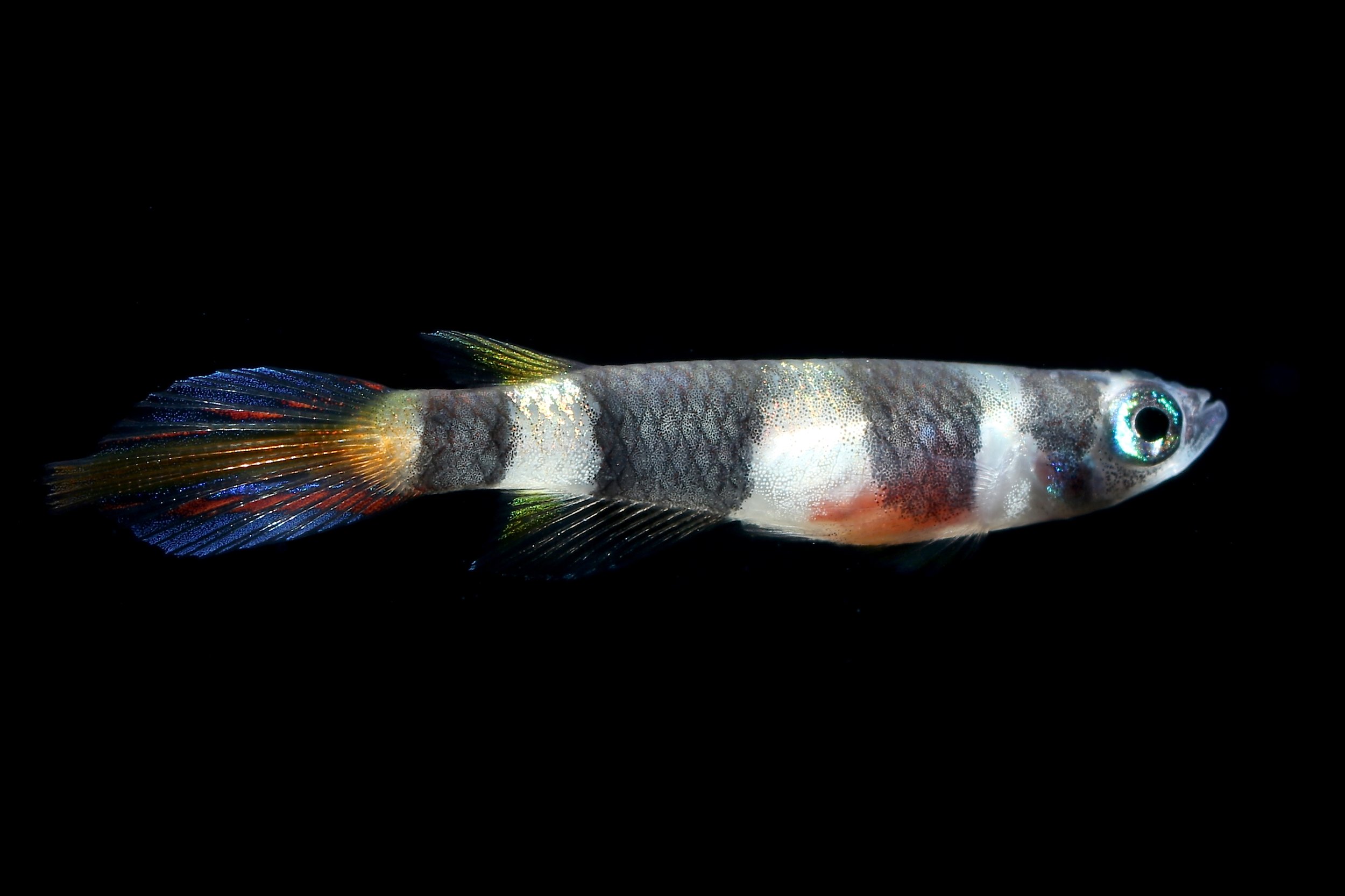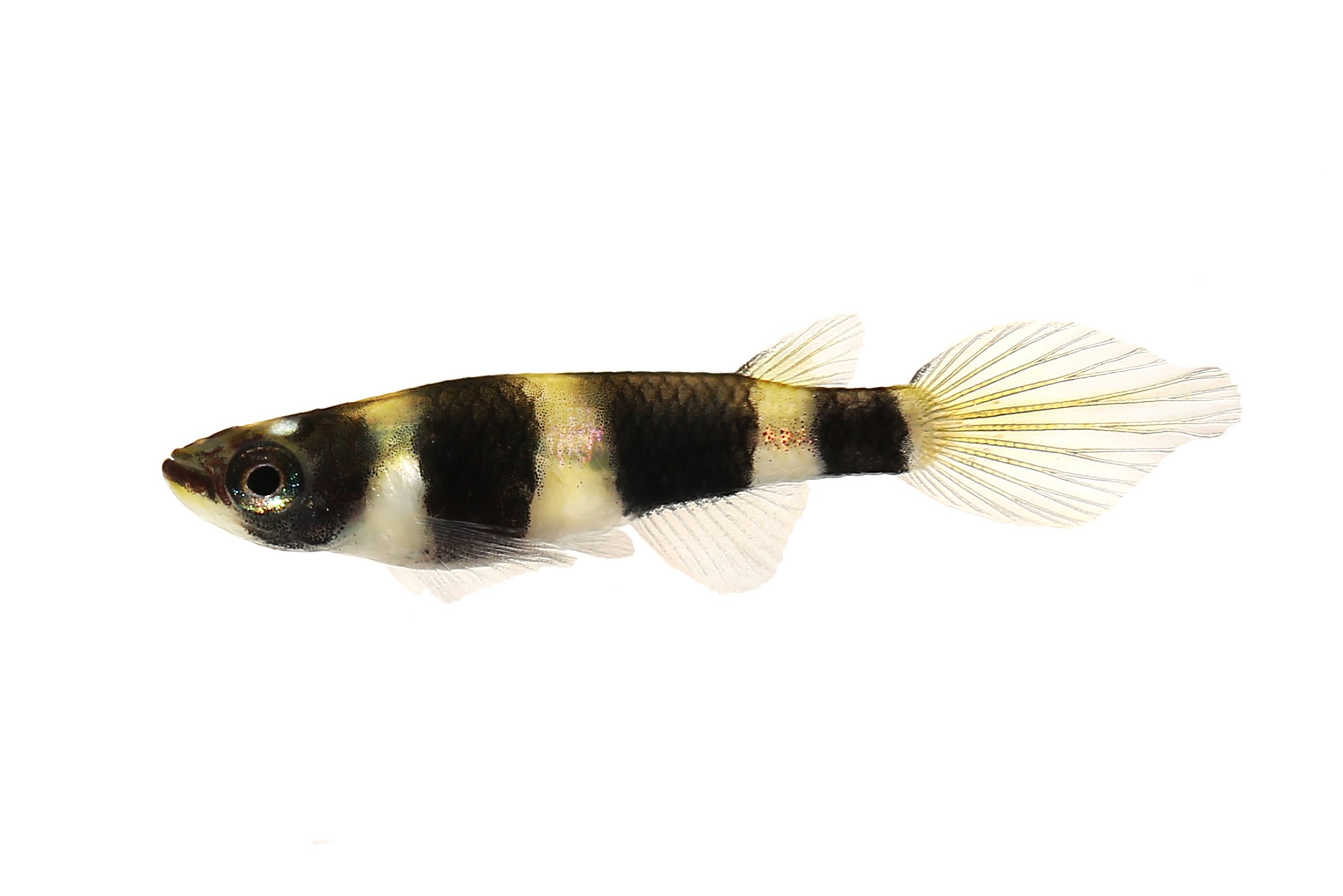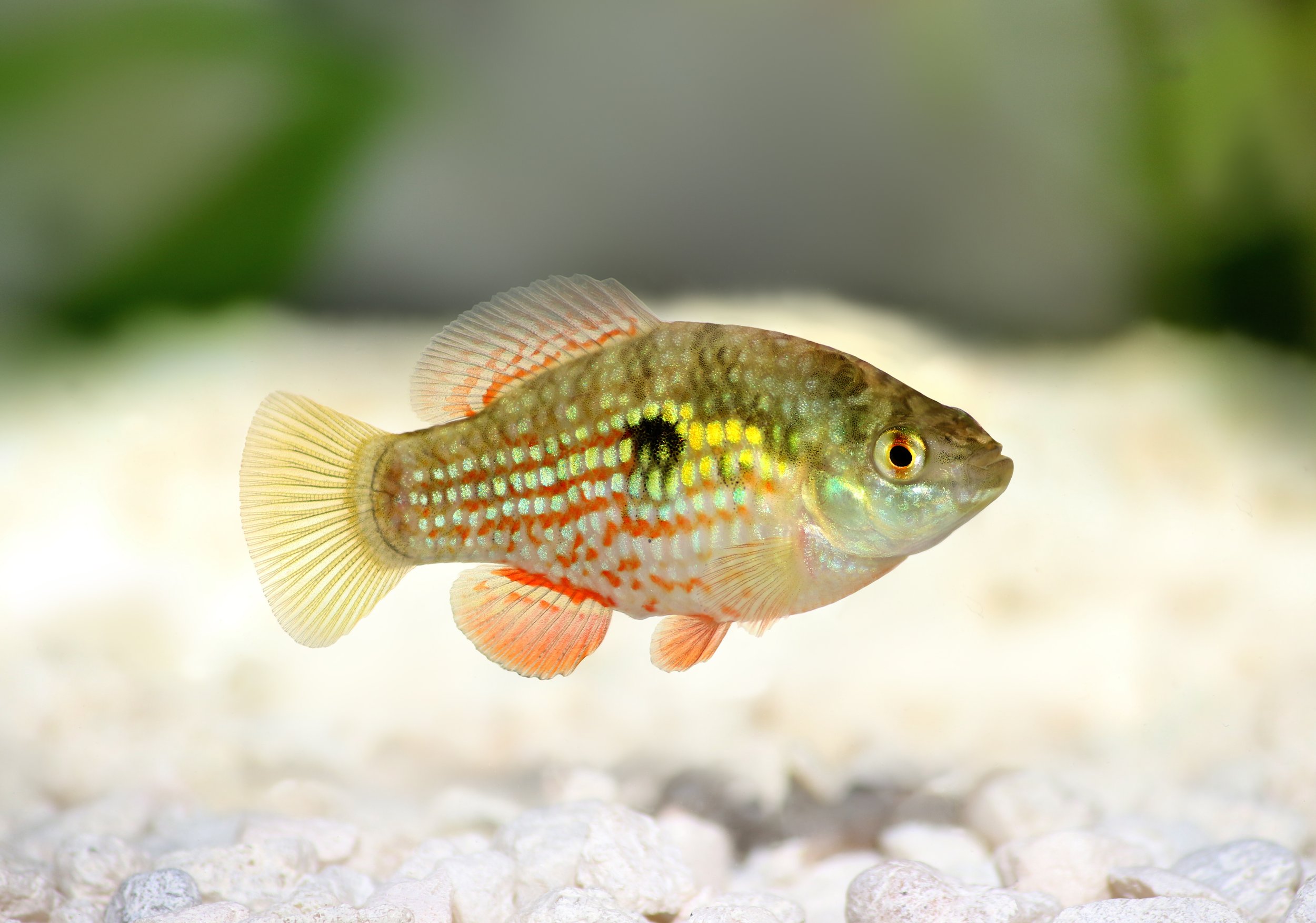 Image 1 of 3
Image 1 of 3

 Image 2 of 3
Image 2 of 3

 Image 3 of 3
Image 3 of 3




Clown Killifish
The Clown Killifish, scientifically known as Epiplatys annulatus, is a small, vibrant, and highly attractive freshwater fish species that has become a favorite among aquarists for its striking appearance and lively behavior. Native to the slow-moving waters of West Africa, particularly in Sierra Leone, Liberia, and Guinea, this killifish adds a unique touch of elegance and color to nano and planted aquariums.
Physically, the Clown Killifish is known for its distinctive and eye-catching pattern. The body is elongated and slender, adorned with alternating bands of black and gold or yellow. The caudal fin is particularly striking, often displaying a bright red or blue coloration with a fan-like shape and distinct eye spots, which resemble the face of a clown, giving the fish its common name. Mature specimens are relatively small, reaching only about 1 to 1.5 inches (2.5 to 4 centimeters) in length, making them ideal for nano aquariums.
In aquariums, Clown Killifish thrive in well-planted tanks with plenty of hiding spots and gentle water flow to mimic their natural habitat. They prefer a tank with floating plants that help diffuse light and provide cover, making them feel secure. These killifish are generally peaceful and can be kept in small groups. However, because of their small size, they should be housed with similarly sized and non-aggressive tank mates to avoid stress and potential harm.
Water parameters for Clown Killifish should closely resemble those of their native environment. They prefer slightly acidic to neutral water with a pH range of 6.0 to 7.5 and temperatures between 72 to 79°F (22 to 26°C). Regular water changes and good filtration are essential to maintain clean and stable water conditions, as these fish are sensitive to poor water quality.
Feeding Clown Killifish is relatively easy, as they are micropredators and will readily accept a variety of small foods. They enjoy live or frozen foods such as daphnia, brine shrimp, and mosquito larvae, which mimic their natural diet. They may also accept high-quality micro-pellets or crushed flakes, but a varied diet that includes live foods will help maintain their vibrant coloration and overall health.
Breeding Clown Killifish in captivity is possible and can be a rewarding experience for aquarists. These fish are egg-layers, typically spawning among fine-leaved plants or spawning mops. The female scatters the eggs, which adhere to the plants or substrate. The eggs hatch in about 10 to 14 days, depending on the temperature. The fry are very small and require microscopic foods like infusoria or freshly hatched brine shrimp to start. Raising the fry in a separate tank with gentle filtration is recommended to ensure their survival.
Overall, the Clown Killifish (*Epiplatys annulatus*) is a delightful and visually stunning addition to freshwater aquariums, prized for its vibrant coloration, peaceful nature, and ease of care. With proper attention to their specific requirements, these tiny yet captivating fish can thrive and bring a unique splash of color and activity to aquarists of all levels of experience, enhancing the beauty and diversity of any aquatic environment.
The Clown Killifish, scientifically known as Epiplatys annulatus, is a small, vibrant, and highly attractive freshwater fish species that has become a favorite among aquarists for its striking appearance and lively behavior. Native to the slow-moving waters of West Africa, particularly in Sierra Leone, Liberia, and Guinea, this killifish adds a unique touch of elegance and color to nano and planted aquariums.
Physically, the Clown Killifish is known for its distinctive and eye-catching pattern. The body is elongated and slender, adorned with alternating bands of black and gold or yellow. The caudal fin is particularly striking, often displaying a bright red or blue coloration with a fan-like shape and distinct eye spots, which resemble the face of a clown, giving the fish its common name. Mature specimens are relatively small, reaching only about 1 to 1.5 inches (2.5 to 4 centimeters) in length, making them ideal for nano aquariums.
In aquariums, Clown Killifish thrive in well-planted tanks with plenty of hiding spots and gentle water flow to mimic their natural habitat. They prefer a tank with floating plants that help diffuse light and provide cover, making them feel secure. These killifish are generally peaceful and can be kept in small groups. However, because of their small size, they should be housed with similarly sized and non-aggressive tank mates to avoid stress and potential harm.
Water parameters for Clown Killifish should closely resemble those of their native environment. They prefer slightly acidic to neutral water with a pH range of 6.0 to 7.5 and temperatures between 72 to 79°F (22 to 26°C). Regular water changes and good filtration are essential to maintain clean and stable water conditions, as these fish are sensitive to poor water quality.
Feeding Clown Killifish is relatively easy, as they are micropredators and will readily accept a variety of small foods. They enjoy live or frozen foods such as daphnia, brine shrimp, and mosquito larvae, which mimic their natural diet. They may also accept high-quality micro-pellets or crushed flakes, but a varied diet that includes live foods will help maintain their vibrant coloration and overall health.
Breeding Clown Killifish in captivity is possible and can be a rewarding experience for aquarists. These fish are egg-layers, typically spawning among fine-leaved plants or spawning mops. The female scatters the eggs, which adhere to the plants or substrate. The eggs hatch in about 10 to 14 days, depending on the temperature. The fry are very small and require microscopic foods like infusoria or freshly hatched brine shrimp to start. Raising the fry in a separate tank with gentle filtration is recommended to ensure their survival.
Overall, the Clown Killifish (*Epiplatys annulatus*) is a delightful and visually stunning addition to freshwater aquariums, prized for its vibrant coloration, peaceful nature, and ease of care. With proper attention to their specific requirements, these tiny yet captivating fish can thrive and bring a unique splash of color and activity to aquarists of all levels of experience, enhancing the beauty and diversity of any aquatic environment.
The Clown Killifish, scientifically known as Epiplatys annulatus, is a small, vibrant, and highly attractive freshwater fish species that has become a favorite among aquarists for its striking appearance and lively behavior. Native to the slow-moving waters of West Africa, particularly in Sierra Leone, Liberia, and Guinea, this killifish adds a unique touch of elegance and color to nano and planted aquariums.
Physically, the Clown Killifish is known for its distinctive and eye-catching pattern. The body is elongated and slender, adorned with alternating bands of black and gold or yellow. The caudal fin is particularly striking, often displaying a bright red or blue coloration with a fan-like shape and distinct eye spots, which resemble the face of a clown, giving the fish its common name. Mature specimens are relatively small, reaching only about 1 to 1.5 inches (2.5 to 4 centimeters) in length, making them ideal for nano aquariums.
In aquariums, Clown Killifish thrive in well-planted tanks with plenty of hiding spots and gentle water flow to mimic their natural habitat. They prefer a tank with floating plants that help diffuse light and provide cover, making them feel secure. These killifish are generally peaceful and can be kept in small groups. However, because of their small size, they should be housed with similarly sized and non-aggressive tank mates to avoid stress and potential harm.
Water parameters for Clown Killifish should closely resemble those of their native environment. They prefer slightly acidic to neutral water with a pH range of 6.0 to 7.5 and temperatures between 72 to 79°F (22 to 26°C). Regular water changes and good filtration are essential to maintain clean and stable water conditions, as these fish are sensitive to poor water quality.
Feeding Clown Killifish is relatively easy, as they are micropredators and will readily accept a variety of small foods. They enjoy live or frozen foods such as daphnia, brine shrimp, and mosquito larvae, which mimic their natural diet. They may also accept high-quality micro-pellets or crushed flakes, but a varied diet that includes live foods will help maintain their vibrant coloration and overall health.
Breeding Clown Killifish in captivity is possible and can be a rewarding experience for aquarists. These fish are egg-layers, typically spawning among fine-leaved plants or spawning mops. The female scatters the eggs, which adhere to the plants or substrate. The eggs hatch in about 10 to 14 days, depending on the temperature. The fry are very small and require microscopic foods like infusoria or freshly hatched brine shrimp to start. Raising the fry in a separate tank with gentle filtration is recommended to ensure their survival.
Overall, the Clown Killifish (*Epiplatys annulatus*) is a delightful and visually stunning addition to freshwater aquariums, prized for its vibrant coloration, peaceful nature, and ease of care. With proper attention to their specific requirements, these tiny yet captivating fish can thrive and bring a unique splash of color and activity to aquarists of all levels of experience, enhancing the beauty and diversity of any aquatic environment.





